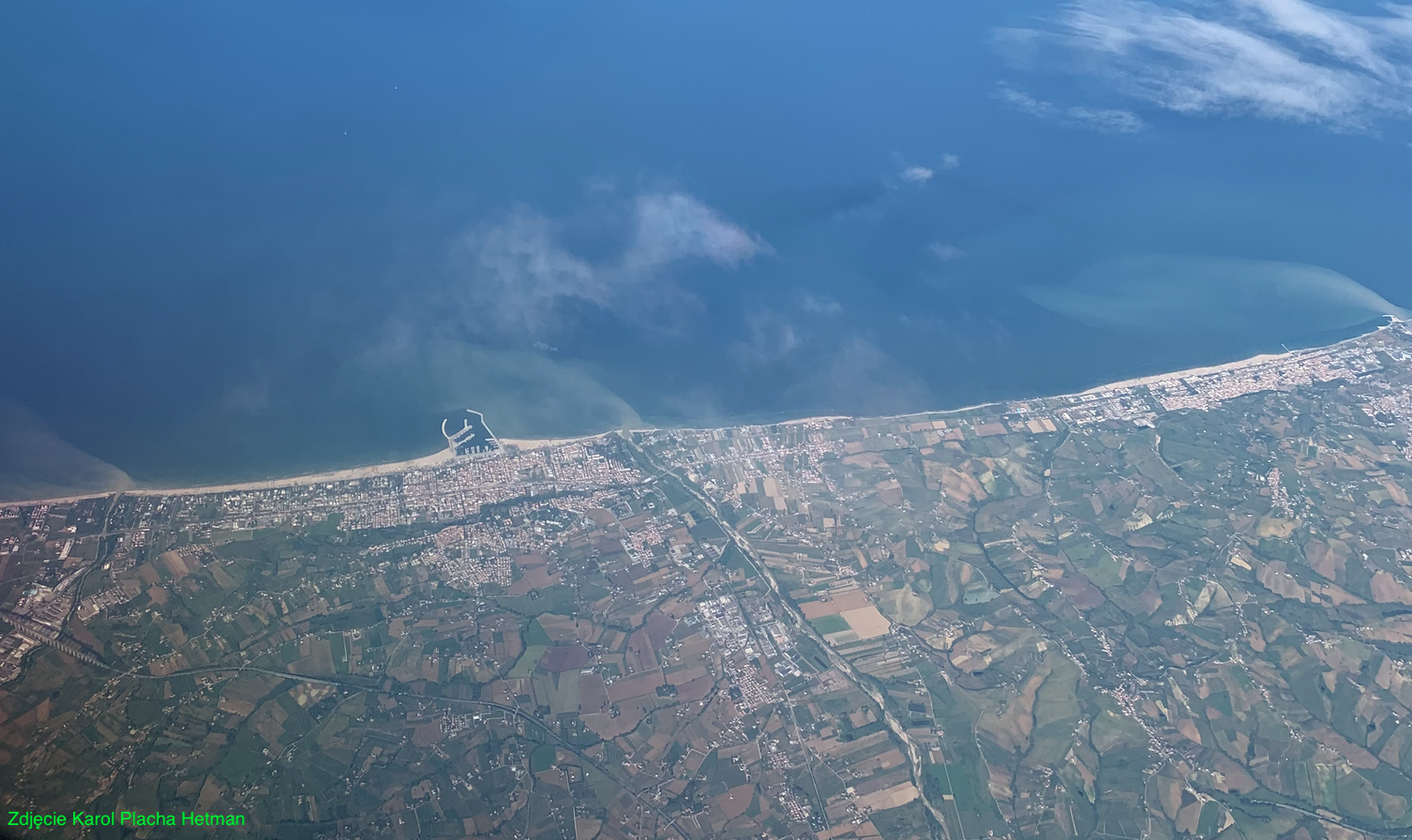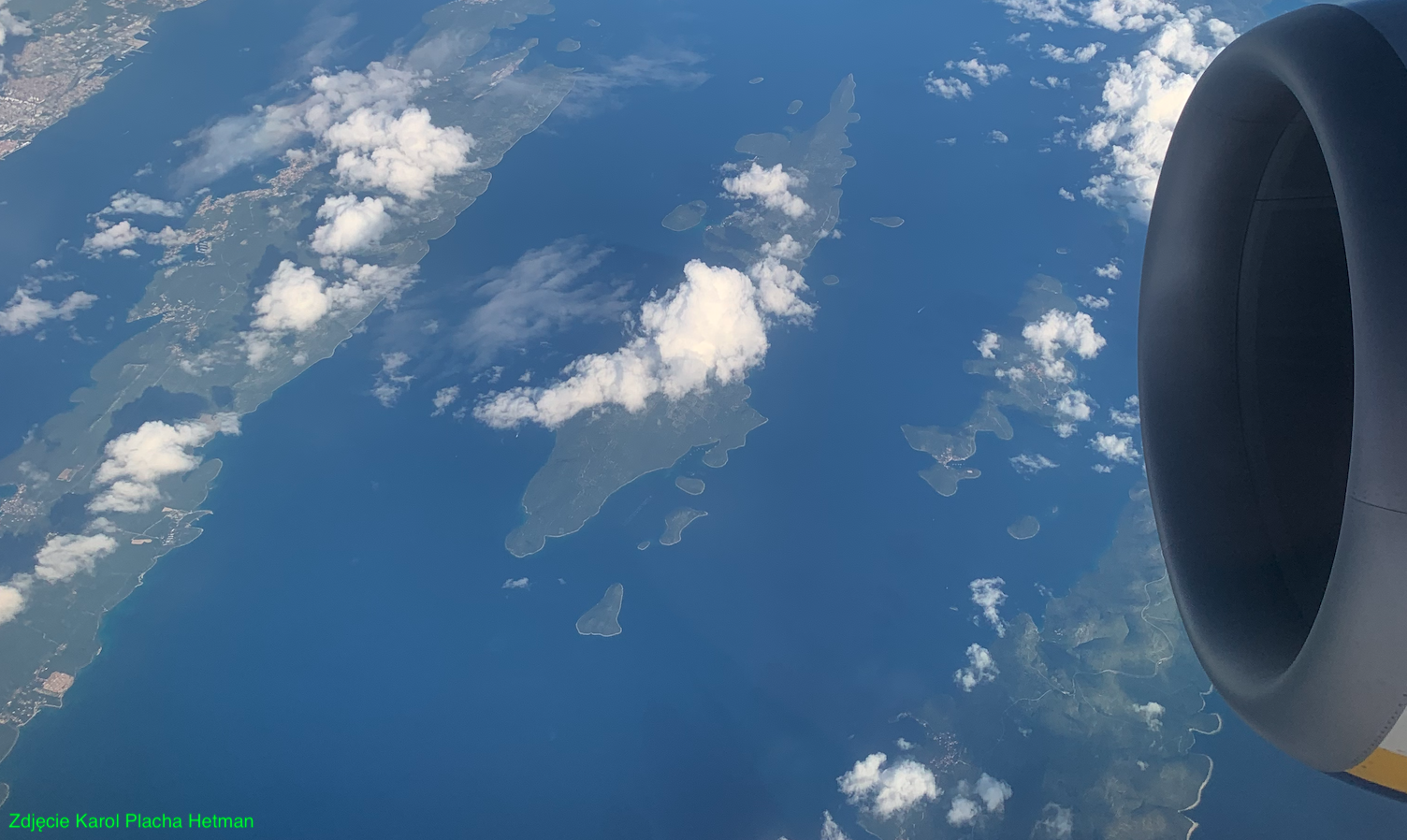Kraków 2023-06-12
Lot z Rzymu do Krakowa. 2023 rok.
W dniu 6 czerwca 2023 roku, odbył się lot na trasie CIA – KRK, który był przeprowadzony przez firmę Ryanair. Rejs wykonano popularnym samolotem Boeing B.737-800, rejestracja SP-RSA, operator BUZZ.
Lotniska w Rzymie.
W tym miejscu parę słów o lotniskach w Rzymie. Aktualnie (2023 rok) Rzym dysponuje dwoma lotniskami komercyjnymi. Pierwsze z nich powstało w miejscowości Ciampino koło Rzymu, w kierunku południowo-wschodnim, w odległości około 15 km od centrum Rzymu. Za datę powstania Lotniska można przyjąć 1918 rok. Lotnisko pełniło funkcje wojskowe. Lecz już w 30-latach XX wieku, zaczął na nim się intensywnie rozwijać ruch pasażerski. Przylatywały tu także samoloty PLL LOT z Warszawy. Ogromny bum transportu pasażerskiego i towarowego nastąpił tuż po zakończeniu drugiej wojny światowej. Lotnisko Ciampino korzystało ze swojego dobrego położenia, na szlaku Północna Afryka i Bliski Wschód oraz Europa Zachodnia ( głównie Francja i Wielka Brytania ). Ówczesne samoloty, napędzane śmigłami, nie dysponowały tak dużym zasięgiem i musiały korzystać z lotnisk pośrednich. W Rzymie trzeba było uzupełnić paliwo w samolotach. Głośno o Lotnisku Ciampino był, kiedy startujące z tego lotniska samoloty brytyjskie De Havilland Comet ( pierwsze na świecie turboodrzutowe samoloty pasażerskie ) ulegały katastrofom. ( Dwukrotnie; 10.01.1954 roku i 8.04.1954 roku ).
Systematycznie wzrastający ruch na Lotnisku Ciampino zmusił Włochy do budowy nowego Lotniska Fiumicino. Budowę rozpoczęto w 1962 roku i jest to obecnie największy port lotniczy Włoch dysponujący trzema terminalami.
W zamyśle, włosi planowali całkowitą likwidacje Lotniska Ciampino. Niemniej jednak, na lotnisku Ciampino bazują samoloty rządowe Republiki Włoch i wojskowe lotnictwo morskie. Te drugie, pełnią funkcje patrolowe obszarów morskich i realizują zadania SAR. To z tego lotniska Papież Jan Paweł II, a następnie Benedykt XVI odlatywali na pielgrzymie szlak. Z drugiej strony, od 2003 roku, w Europie intensywnie rozwija się lotnictwo tak zwane nisko-kosztowe. Irlandzka firma Ryanair znalazła tu jedną ze swoich baz. Tak więc, w najbliższych latach, jest mało prawdopodobne, iż lotnisko Ciampino zostanie zlikwidowane.
Podstawowe dane Lotniska Ciampino ( 2023 rok ). Imię własne – Giovan Battista Pastine. Lotnisko cywilno-wojskowe. Kod CIA ( organizacji IATA ), LIRA ( organizacji ICAO ). Współrzędne: 41°47’57.7″N 12°35’41.77″E Wysokość: 130 m n.p.m. Lotnisko posada jeden RWY o wymiarach 2 207 m x 47 m, na kierunku 15/33, o nawierzchni betonowej. W 2006 roku, lotnisko odprawiło 4 945 158 pasażerów, a w 2018 roku, 5 839 737 pasażerów. W 2007 roku, dobudowano kolejny pawilon odlotowy.
Lotnisko Ciampino.
Na lotnisku CIA pasażerowie przewoźnika Ryanair są odprawiani z hali odlotów A, gdzie znajduje się 8 bramek. Jest jeszcze pawilon „B” i specjalny pawilon „C”. Pomiędzy strefą bezpieczeństwa, a pawilonem odlotowym znajduje się standardowo sklep wolnocłowy. Praktycznie, cały pawilon jest wypełniony siedzenia dla podróżnych. Jest oczywiście bufet i toalety. Z uwagi na brak miejsca, nie ma żadnego kącika rozrywki dla dzieci. Informacje dla podróżnych są wyświetlane na monitorach i podawane są komunikaty audio. Zaletą pawilonu jest możliwość robienia zdjęć startującym i lądującym samolotom, na całej długości RWY. Jednak zdjęcia są robione na tle kolorowych bloków mieszkalnych oraz pobliskiego przystanku kolejowego.
Mimo ogólnej opinii o włochach, odprawy są dokonywane punktualnie i bardzo sprawnie. Włoska obsługa jest fachowa i uprzejma. Po przejściu przez bramkę, wychodzimy na zewnątrz pawilonu i dalsze oczekiwanie na wejście na pokład samolotu, spędza się na wolnym powietrzu. W razie opadów deszczu, pasażerowie są kierowani do krytych niebieskim poliwęglanem korytarzy. Na szczęście, oczekiwanie na wolnym powietrzu jest skrócone do minimum. Wszystko zależy od czasu przylotu samolotu, którym mamy odlecieć i sprawności opuszczenia tego samolotu przez poprzednich pasażerów. Włosi te procedury mają dobrze opanowane. Czasy przelotu są tak zestawione, że jest magnes ewentualnych opóźnień. Na przykład; firma Ryanair przewiduje na lot CIA – KRK czas 120 minut, kiedy faktyczny lot trwa około 90 minut (od chwili startu do lądowania).
Ponieważ nasz samolot stał na płycie peronowej przy pawilonie „A”, dlatego nie było potrzeby transportu pasażerów autobusami peronowymi. Wejście na pokład 189 pasażerów zajmuje około 5-6 minut (przez przednie i tylne drzwi). Dłużej trwa usadzanie się pasażerów na fotelach, bo trzeba włożyć walizki kabinowe (bagaż kabinowy) do schowków nad fotelami. Siedzenia w układzie 3 x 3. Przy każdym fotelu przy burcie jest okno. Samoloty tego typu, z jednym korytarzem, są nazywane wąskokadłubowe. Największe z nich zabierają na pokład do 230 pasażerów ( konfiguracja 1-klasowa ). Są trzy rodzaje pasażerów; Pierwsi pasażerowie są tylko w bagażem podręcznym (jeden egzemplarz), który umieszczają pod fotelem. Druga grupa, to pasażerowie z dwoma bagażami. Mała torebka, którą wkładają pod fotel oraz walizka kabinowa do 10 kg, którą chowa się do schowków nad fotelami. Trzecia grupa, to są pasażerowie, który duży bagaż (do 45 kg) nadali przy odprawie biletowo – bagażowej. Obsługa lotniska ich bagaż wkłada do bagażnika samolotu, który jest pod podłoga kabiny pasażerskiej. Bagażnik ten jest dostępny z zewnątrz przez specjalny luk.
Na lotnisko CIA są używane pojazdy Push-Back, które wypychają samoloty na drogę kołowania. Główne silniki samolotu są uruchamiane po wypchnięciu samolotu. Chodzi o bezpieczeństwo obsługi na lotnisku. Podczas postoju samolotu na płycie peronowej, pracuje mały silnik (turbina) APU, która zasila samolot w energię elektryczną i zapewnia przewietrzanie kabiny pasażerskiej. Samolot kołuje na start już na własnym napędzie. W tym momencie, załoga samolotu utrzymuje łączność radiową z wieżą kontroli lotów.
Samolot Boeing B.737-8AS rejestracja SP-RSA.
Rodzina samolotów Boeing B.737 to jest najpopularniejszy samolot pasażerski na świecie. Do 2022 roku, zbudowano około 8 000 egzemplarzy. Obecnie jest produkowana generacja B.737 MAX, w kilku długościach kadłuba, o różnym maksymalnym zasięgu i z silnikami, które różnią się trochę mocą. Portfel zamówień Koncernu Boeing na samoloty B.737 MAX opiewa na ponad 2 000 egzemplarzy.
Samolot Boeing B.737-8AS firmy Ryanair rejestracja SP-RSA nr 44686 ( 5072 ), operator firma BUZZ. Oddany był do eksploatacji w dniu 09 września 2014 roku. Masa całkowita 79 010 kg, prędkość maksymalna 876 km/h, a przelotowa 840 km/h. Zasięg z ładunkiem ponad 4 000 km. Zespół napędowy to dwa silniki wentylatorowe CFMI CFM56-7B26 o ciągu 2 x 121,4 kN, z odwracaczami ciągu. Załoga składa się z dwóch pilotów i 3 osób personelu pokładowego. W dniu 6 czerwca 2023 roku, samolot wykonał 6 lotów z Krakowa; Dortmund, Rzym, Oslo. Samolot został oblatany w dniu 27 sierpień 2014 roku, ze znakami rejestracyjnymi N1786B w Renton i przekazano do eksploatacji w dniu 9 wrzesień 2014 roku, firmie Ryanair ze znaki rejestracyjnymi EI-FEE. W marcu 2018 roku, papierowo samolot przeniesiono do firmy Ryanair Sun (Polska) z rejestracją SP-RSA, a w październiku 2019 roku, papierowo przeniesiono do firmy BUZZ (Polska) z rejestracją SP-RSA. Samolot w Polsce otrzymał HEX CODE – 48C220 (IDENTYFIKATOR ICAO). Układ jednoklasowy 189 foteli.
W swojej historii samolot Boeing B.737-8AS rejestracja SP-RSA miał dwa incydent. W dniu 12 listopada 2019 roku, samolot numer rejestracyjny SP-RSA, wykonywał lot FR-6864 z Krakowa (Polska) do Palermo (Włochy), wznosił się z krakowskiego pasa startowego na kierunku 07, kiedy załoga poprosiła o wyrównanie poziomu na wysokości 6 000 stóp, z powodu problemu z przekładnią. Załoga przepracowała powiązane listy kontrolne i zdecydowała się na powrót do Krakowa i bezpiecznie wylądowała z powrotem na pasie startowym 07, około 55 minut po starcie. Zastępczy Boeing 737-800, o rejestracji SP-RST dotarł do Palermo lotem FR-6866 z 3-godzinnym opóźnieniem. Awarię samolotu SP-RSA usunęli technicy z koncernu Boeing.
Drugi incydent. W dniu 21 stycznia 2021 roku, samolot SP-RSA wykonywał lot FR-6329 z Sofii (Bułgaria) do Barcelony (Hiszpania), gdzie wylądował na RWY 25L w Barcelonie. Po przyziemieniu, w kokpicie załogi, przed kapitanem statku, na przedniej szybie powstało pojedyncze pęknięcie. Szybę wymieniono w tym samym dniu i samolot powrócił do eksplotacji.
Lot do Krakowa. 6 czerwiec 2023 rok.
Samolot ruszył i z prędkością około 35 km/h kołował na RWY 15. Zatrzymał się na przewiązce przed drogą startową, aby bezpiecznie wylądował inny samolot. Kiedy załoga dostała zgodę na start, maszyna ruszyła i nie zatrzymując się jak zwykle na początku drogi startowej, tylko startuje. Dzięki temu zajmuje minimalny czas na pasie startowym i szybko go opuszcza. Jest to szczególnie ważne przy lotniskach z jedną drogą startową i dużym ruchu, a takim lotniskami są Ciampino i Balice.
Start na kierunku RWY 15. Rozbieg twa około 45 sekund. (Od momentu wyjazdu na RYW do oderwania się od RYW). Samolot odrywa się od ziemi mniej więcej przy 1 600 metrze RWY. I szybko wznosi się w górę. Procedury kontroli przestrzeni powietrznej skierowały samolot nad morze Tyrreńskie, czyli w prawo i po około 10 km, będąc niemal na wysokości przelotowej obrał kurs na Polskę, poprzez skręt w lewo. Lot przebiegał na pułapie około 10 500 m. Już nad Słowacją załoga rozpoczęła zniżać pułap lotu. Na wysokości Nowego Targu, załoga zmieniła kurs na północno-zachodni, aby podjeść do lądowania od strony zachodniej RWY w Krakowie. Start to była godzina 15;27. Lądowanie to była godzina 17;02. Czas przelotu 1 h 35 min. Dobieg 41 sekund. Od momentu zetknięcia podwozia z RYW, do prędkości kołowania około 35 km/h. Lądowanie nastąpiło 12 minut przed czasem.
Opracował Karol Placha Hetman



